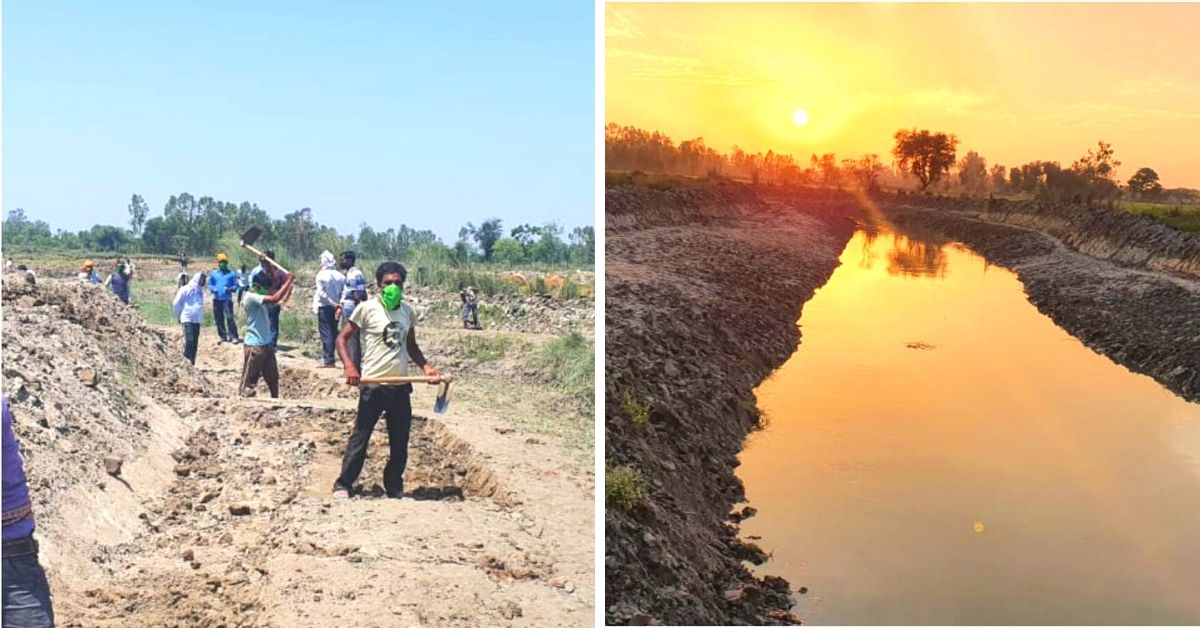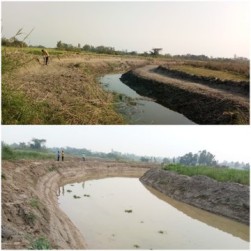IAS Officer Uses Lockdown Time to Restore River, Generate Jobs for 800 People!
As COVID-19 cases are on a steady rise and lockdown has affected thousands of wage earners, this IAS officer made the most of the situation and optimised the available resources to solve two problems.

35-year-old Nathu was one of the fortunate ones to have travelled back home right before the nationwide lockdown in March.
A resident of Mavaiya village in Barabanki district in Uttar Pradesh, he was out of a job after his labour team in Lucknow was asked to stop working.
Meanwhile, Manoj, another daily wage earner, was stranded in the village due to lockdown and movement restriction.
In an interesting turn of events, they were both employed to restore a 2.6 km stretch of the Kalyani river in Mavaiya two months ago.
Likewise, close to 800 villagers who had lost their jobs or whose livelihoods had been affected due to the global pandemic, were employed under this river project started by District Magistrate Dr Adarsh Singh.
यह लघु सरिता का बहता जल
कितना शीतल, कितना निर्मल
तन का चंचल मन का विह्वल
गंगा, यमुना, सरयू निर्मल
यह लघु सरिता का बहता जलग्राम पंचायत मवैया, विकास खंड फतेहपुर में #कल्याणी_नदी को मनरेगा के अंतर्गत पुनर्जीवित करने की कार्य आरंभ होने से पहले एवं कार्य की समाप्ति की कुछ तस्वीरें। https://t.co/9nRZkJskqE pic.twitter.com/rDTc21Dmvi
— District Magistrate Barabanki (@BarabankiD) June 18, 2020
The river restoration project was covered under the Mahatma Gandhi National Rural Employment Guarantee Scheme (MNREGS) and a budget of more than Rs 59 lakh was sanctioned for it in phase 1.
The project is divided into segments – a 2.6 km stretch in Mavaiya, which has been restored, and the other 1.5 kilometres in a neighbouring village, Haidargarh, where work is ongoing.
Kalyani river was once the source of irrigation for farmers but the river dried up from silt accumulation. Last year, the district administration had initiated the plan to clean the river but due to lack of manpower, it was halted.
“Lockdown was, in a way, a boon in disguise for us. We had to stop in February due to movement restrictions. When we learnt about the plight of daily wage earners and how their livelihoods were in danger, we thought of employing them to solve the two problems,” IAS Singh tells The Better India.
How the River Stretch Was Revived in 60 Days

To achieve this feat, the IAS officer, Deputy commissioner, MNREGA-Barabanki, ND Dwivedi and Block Development officer Hemanth Kumar Yadav, adopted measures such as sensitising villagers, eliminating encroachments, reducing garbage dumping, and open defecation on the river bank.
After officially registering 500 odd workers in Mavaiya cleanup and 300 in Haidargarh, the officials instructed the workers about the process.
What separates this project from rest of the river cleanups is the excitement to work, Yadav shares with TBI, “This project came as a ray of hope for several villagers who were struggling. Another reason was that if the river was rejuvenated, then it would ultimately benefit them. This project aims at conserving water and recharging the groundwater.”
The next step was to remove encroachments that were in close quarters with the river. Police and the Revenue department stepped in to make the task easier.
The district authorities also sensitised people about open defecation and dumping garbage in the river, “It wasn’t difficult to get people’s cooperation after we told them they could use the river water for farming,” adds Dr Singh.
The daily wage earners removed the silt, dug the river 1.5-metre deep, and widened it by 25 metres to capture and store rainwater. They also repaired the catchment area.
It took nearly 60 days to desilt the stretch in Mavaiya. The work in Haidargarh is nearing completion, and as per Dr Singh, it should be done by 30 June.
“Since the first phase of our project was successful, we plan to expand it to other villages as the Kalyani river is 170-kilometres long. Now, that we got the required manpower, skills, and knowledge on how to go about it, we will replicate the model in other villages post-monsoon,” adds Dr Singh
India has been under the lockdown for nearly three months and thousands of lives have been uprooted due to loss of jobs.
Meanwhile, the COVID-19 cases are on a steady rise, posing uncertainty for the future. So, the best thing is to make most of the situation and optimise the available resources. Officers like Singh make for an inspiring example.
(Edited by Shruti Singhal)
Like this story? Or have something to share?
Write to us: [email protected]
Connect with us on Facebook and Twitter.

Similar Story

Ex-IRS Officer’s Free UPSC CSE Course Eliminates Need for Paid Coaching
An IRS officer-turned-educator, Ravi Kapoor has mentored thousands of UPSC aspirants for free. Taking upon his 10 years of bureaucratic experience and masters in clinical psychology, Ravi’s approach to UPSC mentorship has always kept mental fitness and motivation in focus.
Read more >
If you found our stories insightful, informative, or even just enjoyable, we invite you to consider making a voluntary payment to support the work we do at The Better India. Your contribution helps us continue producing quality content that educates, inspires, and drives positive change.
Choose one of the payment options below for your contribution-
By paying for the stories you value, you directly contribute to sustaining our efforts focused on making a difference in the world. Together, let's ensure that impactful stories continue to be told and shared, enriching lives and communities alike.
Thank you for your support. Here are some frequently asked questions you might find helpful to know why you are contributing?


This story made me
-
97
-
121
-
89
-
167












